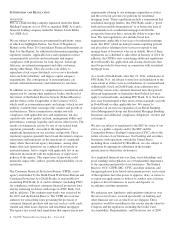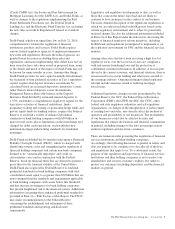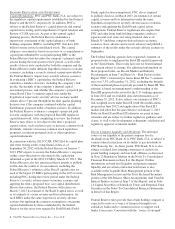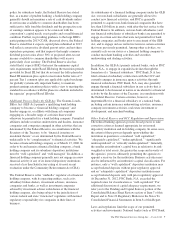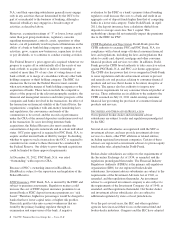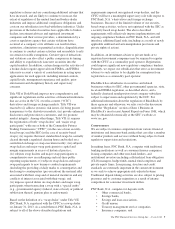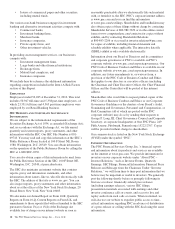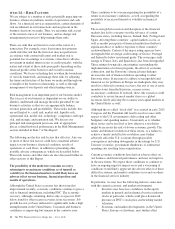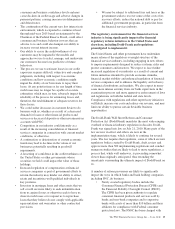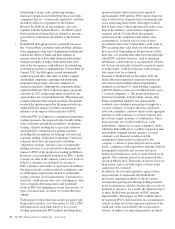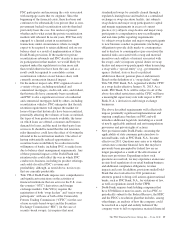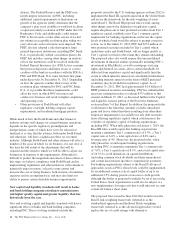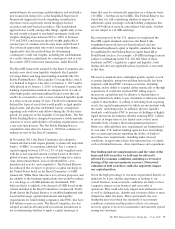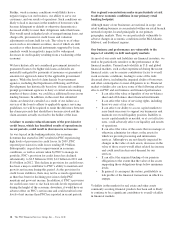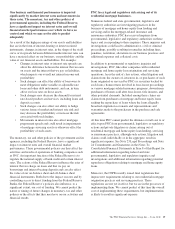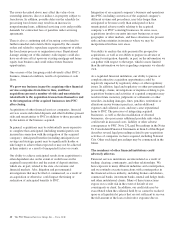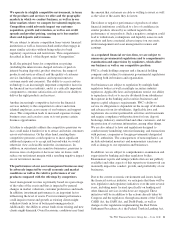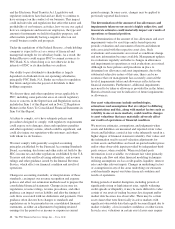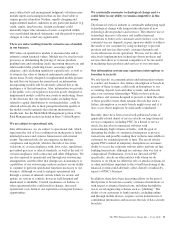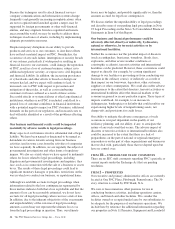PNC Bank 2012 Annual Report Download - page 33
Download and view the complete annual report
Please find page 33 of the 2012 PNC Bank annual report below. You can navigate through the pages in the report by either clicking on the pages listed below, or by using the keyword search tool below to find specific information within the annual report.identifying systemic risks, promoting stronger
financial regulation and identifying those non-bank
companies that are “systemically important” and thus
should be subject to regulation by the Federal
Reserve. In addition, in extraordinary cases and
together with the Federal Reserve, the FSOC could
break up financial firms that are deemed to present a
grave threat to the financial stability of the United
States.
• Dodd-Frank (through provisions commonly known as
the “Volcker Rule”) prohibits banks and their affiliates
from engaging in some types of proprietary trading and
restricts the ability of banks and their affiliates to
sponsor, invest in or have other financial relationships
with private equity or hedge funds. In October 2011,
four of the five agencies with authority for rulemaking
issued proposed rules to implement the Volcker Rule. In
January 2012, the fifth agency issued substantially
similar proposed rules. The rules set forth a complex
and detailed compliance, reporting and monitoring
program for large banks, and seek comments on
numerous questions. Although the comment deadline
expired in February 2012 on the four agency proposals
(and later in 2012 on the single agency proposal), the
agencies have not yet issued final rules. The timing and
content of the final rules remain uncertain. The manner
in which the questions posed by the proposed rules are
addressed by the agencies will have an important
influence on the impact of the final rules on PNC.
Although PNC no longer has a designated proprietary
trading operation, the proposed rules broadly define
what constitutes potentially prohibited “proprietary
trading,” thereby making the scope of the statutory
and regulatory exemptions for trading activities,
including the exemptions for hedging activities and
customer trading, all the more important. Until more
is known about how the final rules will define
“proprietary trading” and the scope of permissible
trading activities, it is not possible to determine the
impact to PNC of the proprietary trading prohibition.
However, any meaningful limitation on PNC’s ability
to hedge its risks in the ordinary course or to trade on
behalf of customers would likely be adverse to
PNC’s business and results of operations. In addition,
the proposed rules contain extensive compliance and
recordkeeping requirements related to permissible
trading activities. Such requirements, if included in a
final rule, could increase the costs of hedging or other
types of permissible transactions and potentially
result in PNC not engaging in certain transactions, or
types of transactions, in which we would otherwise
engage.
With respect to the restrictions on private equity and
hedge fund activities, as of December 31, 2012, PNC
held interests in such funds likely to be covered
totaling approximately $859 million including three
sponsored funds with total invested capital of
approximately $389 million. PNC expects that over
time it will need to eliminate these investments and
cease sponsoring these funds, although it is likely
that at least some of these amounts will reduce over
time in the ordinary course before compliance is
required, and the Volcker Rule also permits
extensions of the compliance date under some
circumstances. A forced sale of some of these
investments due to the Volcker Rule could result in
PNC receiving less value than it would otherwise
have received. Depending on the provisions of the
final rule, it is possible that other structures through
which PNC conducts business, such as operating
subsidiaries, joint ventures or securitization vehicles,
but that are not typically referred to as private equity
or hedge funds, could be restricted, with an impact
that cannot now be evaluated.
• Pursuant to Dodd-Frank, in December 2011 the
Federal Reserve requested comment on proposed
rules that would establish enhanced prudential
standards governing U.S. bank holding companies
with $50 billion or more in consolidated total assets
(“covered companies”). The proposed enhanced
prudential standards would include, among other
things, heightened liquidity risk management
standards; new standards governing oversight by a
covered company’s board of directors and board-
level risk committee; and new limits on the aggregate
amount of credit exposure a covered company may
have to any single customer or counterparty. These
proposed rules also would establish an “early
remediation” regime for covered companies, under
which the Federal Reserve would be required to take
increasingly stringent actions against a covered
company as its financial condition or risk
management deteriorated as reflected by the
company’s current or projected post-stress capital
levels, compliance with supervisory liquidity and risk
management standards and, in some instances,
market-based indicators, such as credit default swap
spreads. The comment period on the proposed rules
closed in March 2012. Final rules, however, have not
been issued, and as such the impact of these rules
cannot now be evaluated.
• In addition, the relevant regulatory agencies have
proposed rules to implement the Dodd-Frank
provisions requiring retention of risk by certain
securitization participants through holding interests
in the securitization vehicles, but the rules are not yet
finalized or effective. As a result, the ultimate impact
of these Dodd-Frank provisions on PNC remains
unpredictable. That impact on PNC could be direct,
by requiring PNC to hold interests in a securitization
vehicle or other assets that represent a portion of the
credit risk of the assets held by the securitization
vehicle, or indirect, by impacting markets in which
14 The PNC Financial Services Group, Inc. – Form 10-K


